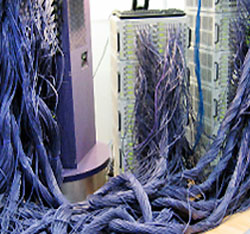Resolving line check problems can be quick and easy when you use the following three-step approach. It’s simple, it follows a logical flow, and it can be done in a very short period of time.
A line check is the process of checking that all instruments and microphones on the stage are sending signals to the sound board. This process happens before a sound check or might be considered part of the sound check.
During a line check, you’re apt to discover problems like bad cables, bad connections, dead batteries, and (gasp!) dead mixer channels.
I think of it as more than just getting the signal, but also getting a clear signal as well. In some cases of line check problems, you will neither get volume nor a signal light on the channel. While the lack of the signal light can determine what you check, using the below process list, you’ll find out everything that should be checked when either case arises.
Let’s say a singer is singing into a microphone and you don’t hear anything coming through the main loudspeakers.
Step One: Check For the Obvious
These are all things you can do from the sound booth and/or have the person on stage easily check for you.
1) Channel fader. Make sure it’s at the 0 position as a good starting point.
2) Channel gain. Check that the channel gain is turned up. If you aren’t seeing the signal light on the channel glowing on and off, then increase the gain to see if that’s the source of the problem.
3) Channel padding. Make sure you haven’t engaged the signal padding where it’s not needed. That could cut your signal so low you don’t hear anything.
4) Sound board volume. Make sure you have the master volume turned up on your sound board. (Hey, I wouldn’t mention it if I hadn’t done it myself.)
5) Subgroup usage. Make sure the channel isn’t routed to a subgroup. If it is, take it out of the subgroup and listen for the sound.
6) Wireless microphones—receiver power and signal. Make sure the receiver is turned on and the receiver shows a wireless signal. If you don’t see a wireless signal, ask the person on stage to make sure the wireless pack (or wireless handheld) is on. If it’s on but the pack/handheld doesn’t show any associated power light, it might be as simple as battery replacement. See your wireless microphone manual for how it displays a battery-strength light indicator.
7) Wired microphones. Make sure that if it has an on/off switch that it’s turned on. Ask the person on stage.
8) Channel/stage jack pairing. Sometimes, a problem can be as simple as the cable being plugged into the wrong stage jack or you have it marked as the wrong channel. Ask the person on stage to check the jack number.
Step Two: Follow The Signal Flow
1) Connection into microphone. Re-seat the cable into the microphone. Make sure the channel is off/muted when you do this.
2) Connection at stage jack. Re-seat the cable into the stage jack. Again, make sure the channel is off/muted when you do this.
3) Connection at mixer. It’s unlikely but it’s “possible” that the connection into the mixer was pulled out for that channel. Make sure it’s properly connected.
Step Three: Time To Swap
1) Swap microphones. Swap the microphone for known good one and try again. You might have a microphone that’s gone bad.
2) Swap cables. Swap the microphone cable with a cable that’s known to work.
3) Swap stage jacks. Still not getting a signal to the sound booth? Might be something from the stage jack to the mixer itself. Connect to a different jack/channel and see if the mixer gets that signal.
If that does get a signal, also try swapping cables on the back of the mixer from the good channel to the channel that wasn’t receiving the signal. If you still don’t have a signal, you have a bad channel on your board.
Summary
Follow this three-step approach to resolving line check problems with vocal microphones and you’ll be moving on to your sound check faster than a vocalist can say “Testing 1, 2, 3.“
Ready to learn and laugh? Chris Huff writes about the world of church audio at Behind The Mixer. He covers everything from audio fundamentals to dealing with musicians. He can even tell you the signs the sound guy is having a mental breakdown.





















